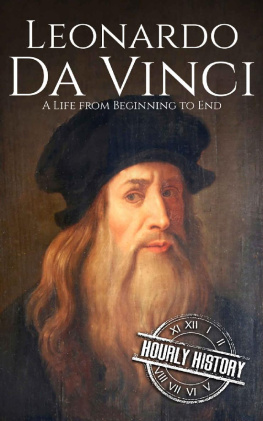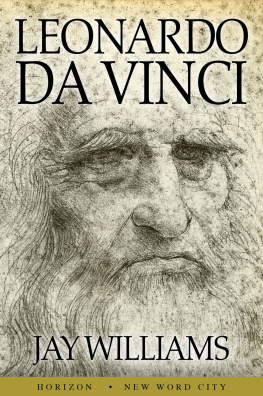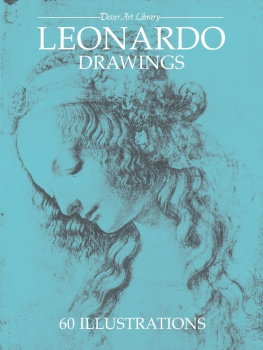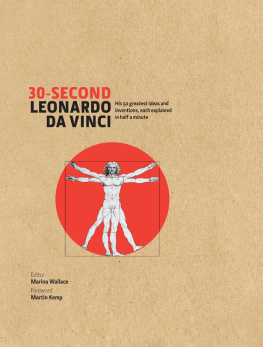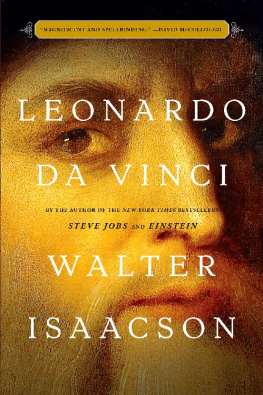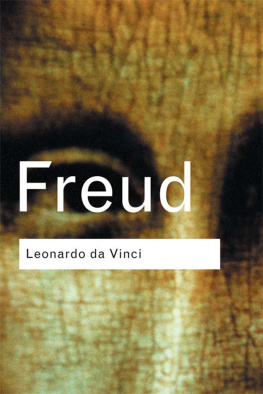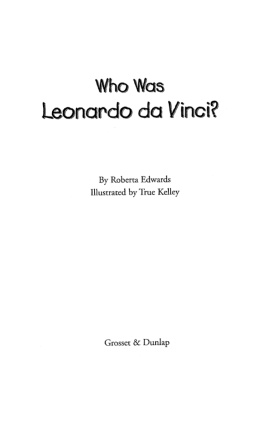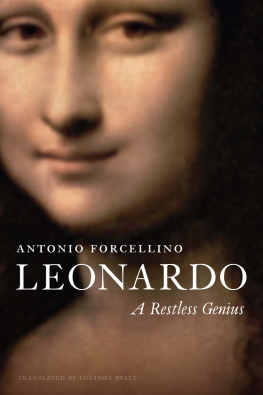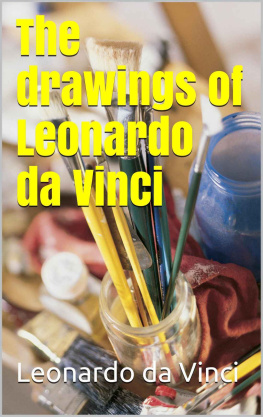Contents
Guide
Pages

LEONARDO
A RESTLESS GENIUS
ANTONIO FORCELLINO
TRANSLATED BY LUCINDA BYATT
polity
First published in Italian as Leonardo: Genio senza pace First published in Italy by Gius. Laterza & Figli, 2016. This edition published by arrangement with Grandi & Associati.
This English edition Polity Press, 2018
The right of Lucinda Byatt to be identified as translator of this work has been asserted in accordance with Section 77 of the Copyright, Designs and Patents Act 1988
This book has been translated thanks to a translation grant awarded by the Italian Ministry of Foreign Affairs and International Cooperation.
Questo libro stato tradotto grazie ad un contributo alla traduzione assegnato dal Ministero degli Affari Esteri e della Cooperazione Internazionale italiano.
Polity Press
65 Bridge Street
Cambridge CB2 1UR, UK
Polity Press
101 Station Landing
Suite 300
Medford, MA 02155, USA
All rights reserved. Except for the quotation of short passages for the purpose of criticism and review, no part of this publication may be reproduced, stored in a retrieval system, or transmitted, in any form or by any means, electronic, mechanical, photocopying, recording or otherwise, without the prior permission of the publisher.
ISBN-13: 978-1-5095-1855-5
A catalogue record for this book is available from the British Library.
Library of Congress Cataloging-in-Publication Data
Names: Forcellino, Antonio, author. | Translation of: Forcellino, Antonio. Leonardo.
Title: Leonardo : a restless genius / Antonio Forcellino.
Other titles: Leonardo. English
Description: Medford, MA : Polity Press, 2018. | Includes bibliographical references and index.
Identifiers: LCCN 2017043968 (print) | LCCN 2017044512 (ebook) | ISBN 9781509518555 (Epub) | ISBN 9781509518524 (hardback)
Subjects: LCSH: Leonardo, da Vinci, 1452-1519. | Artists--Italy--Biography. Classification: LCC N6923.L33 (ebook) | LCC N6923.L33 F6613 2018 (print) | DDC 709.2--dc23
LC record available at https://lccn.loc.gov/2017043968
The publisher has used its best endeavours to ensure that the URLs for external websites referred to in this book are correct and active at the time of going to press. However, the publisher has no responsibility for the websites and can make no guarantee that a site will remain live or that the content is or will remain appropriate.
Every effort has been made to trace all copyright holders, but if any have been inadvertently overlooked the publisher will be pleased to include any necessary credits in any subsequent reprint or edition.
For further information on Polity, visit our website: www.politybooks.com
PROLOGUE
On 13 January 1490, the rooms of the castle at Porta Giovia, Milan, were brightly lit to celebrate a feast that would be chronicled as one of the most elegant of the Italian Renaissance, and certainly the most elegant at the Sforza court. Ludovico [Sforza, known as] il Moro, who had ruled Milan with an iron fist for over a decade, wished to honour the new duchess, Isabella of Aragon, granddaughter of the king of Naples, who had married Gian Galeazzo Sforza one year earlier: a legitimate heir to the duchy, yet deprived of all power by his uncle. The feast and its golden decorations were intended to silence the rumours that had circulated for over a year in the corridors of European courts regarding Gian Galeazzos failure to deflower young Isabella, who was as pure and virginal in Milan as she was when she left Naples.
A hundred young maidens from the cream of Milans noble families had been selected for the evening, accompanied by as many knights. In the palace chapel a tribune had been constructed to accommodate the guests and, facing it, a small stage, decked in satin cushions like a throne, where the ducal family sat with its most honoured guests. A powerful, hard-working city like Milan had not dedicated many occasions to such luxurious display in the past years, but now Ludovico il Moro intended to follow the example of his friend, Lorenzo de Medici, who had transformed festivities of this kind into an instrument of government.
This goes some way towards accounting for the amazement of the guests who, having climbed the stairs, found themselves in a room brightly illuminated by candles and whose walls were embellished with precious fabrics and verdant festoons interlaced with ribbons. At the back of the room a closed hemispherical object was just visible, raised on a platform. Many speculated that it was a huge egg, cut in half and covered over with a satin cloth. Curiosity stimulated glances and speculation among the guests, who were dressed in their finest attire. When the room was full, the pipes and drums struck up as the young duchess made her appearance (or perhaps it would be more apt to say her apparition), dressed in a white silk cloak that covered her gold brocade gown.
Giving everyone the time to admire her, Isabella took her place on the small throne. She wore such ornate jewels that the ambassador of the Este [rulers of Ferrara], whose account of the feast has survived, reported that he thought he was looking at the sun, such was the beauty of her figure and the magnificence of her Spanish elegance. When the music struck up again she danced two very graceful dances with three young women from her retinue and for a few minutes she successfully rivalled the great Ludovico himself as the focus of attention. In honour of the duchess and of the Neapolitan court, he, too, had dressed in Spanish style, wearing a dark red velvet doublet trimmed with ermine and a black cloak lined with gold brocade on a white backing. It was an outfit that must have cost many thousand scudi, as many of the guests remarked.
The dancing continued for two hours, giving both Ludovico and Isabella time to savour the triumph of the occasion in full. Even the ambassador of the Grand Turk, who had ridden on horseback into the room and then sat on cushions at the foot of the throne, after the custom at his own court, delivered a message of good wishes and stressed that the Ottoman sultan did not usually send dignitaries to festivities organized by infidels, but that a special honour had been granted to the court of Milan and that of Naples.
Excitement among the guests reached a climax when the duke silenced the musicians and turned to look at the back of the room where, as if by magic, the silken cloth slipped off the enormous hemisphere, revealing a mock cavern lined with gold and stars, in imitation of the celestial vault. Cries of amazement rose from the room as the guests watched the seven planets in the sky light up with the signs of the Zodiac. It was a representation of paradise, whose beauty outshone the inventions of any painter who had previously tried to imagine it in colour. Starting with Jupiter, the planets were celebrating the young duchesss virtues in verses composed by Bellincioni, the court poet. Many in Milan found his compositions too flowery and specious, but that evening even courtiers with more sophisticated tastes found nothing to criticize. Even the expensive garments and jewels of the noble citizens faded into insignificance in an instant, as general attention was gripped by a scenic machine that appeared to be nothing short of miraculous.
Not that mechanical equipment of this kind was a novelty at Italian court festivities. For example, every Good Friday a representation of Christs Passion had been enacted in Rome, at the Colosseum, for as long as anyone could remember, during which angels flew around a cross suspended from pulleys and chains that were prepared months in advance by the ingenious members of the confraternity of San Giovanni Decollato. But the mechanisms had always been quite visible in such plays, while at the Castle in Milan that evening nothing seemed prepared, no wheels jammed, the complex mechanics of the whole apparatus were so clever and so well concealed that their naturalness was disturbing. Many of the guests looked around the room, searching for the inventor of that extraordinary stage machine and the equally stunning masquerades.


